The Spanish insurance market in 2021
Author: MAPFRE Economics
Summary of report’s conclusions:
MAPFRE Economics
The Spanish insurance market in 2021
Madrid, Fundación MAPFRE, July 2022
The Spanish insurance sector is currently immersed in an economic environment that continues to be dynamic, which is reflected in the form of significant growth in its business volume. However, a marked economic slowdown is expected in the coming months and the sector is facing an average inflation rate of around 9% so far this year through September, so that the growth in premiums at the aggregate level is not sufficient to offset the high inflation. This inflationary process also continues to erode the profitability of the insurance entities and maintains high pressure on insurance prices.
The aggregate premium volume of the Spanish insurance market climbed to 61.83 billion Euros in 2021, growth of 5.0% (-8.2% in 2020) recovering the growth trend, but not reaching the levels prior to the start of the pandemic. The partial recovery of the Spanish economy and a greater sensitivity to risk as a result of the pandemic helped to develop the insurance business, especially in Health and Multirisk insurance, which were the drivers of growth of the Non-Life business, and Life Insurance, while in the latter segment the base effect was significant, as when compared to pre-pandemic premiums, it still is a long way from recovery (see Chart 1).
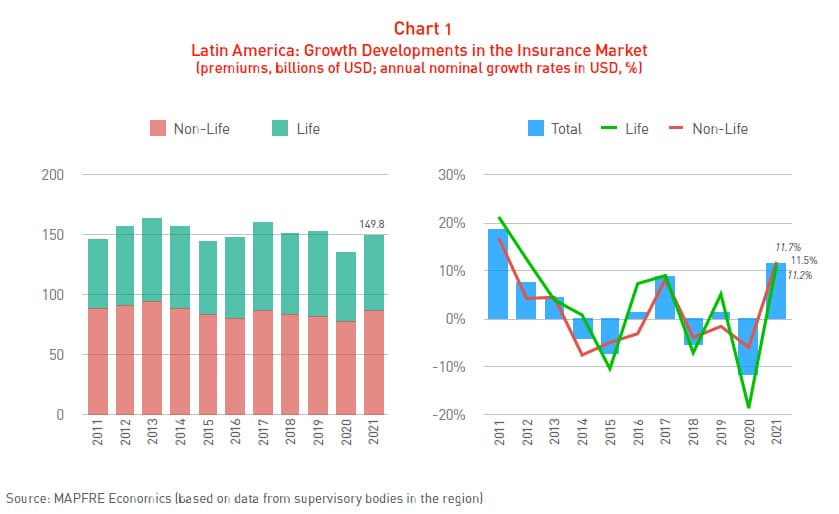
2022 Progress
Analyzing the data from the first nine months of 2022, it is evident that the insurance sector continues to show positive performance, with premium growth of 5.7%, slightly below what was earned in 2019 (-1.8%). The driver for Life Insurance comes from savings insurance and in Non-Life from Multirisk insurance (5.9%) and Health (7.3%). Automobile Insurance has started on the road to recovery in 2022, with a premium volume of 8.52 billion Euros in September of that year, which is an increase of 3.2% over the same period the year before, recovering pre-pandemic levels (see Chart 2).
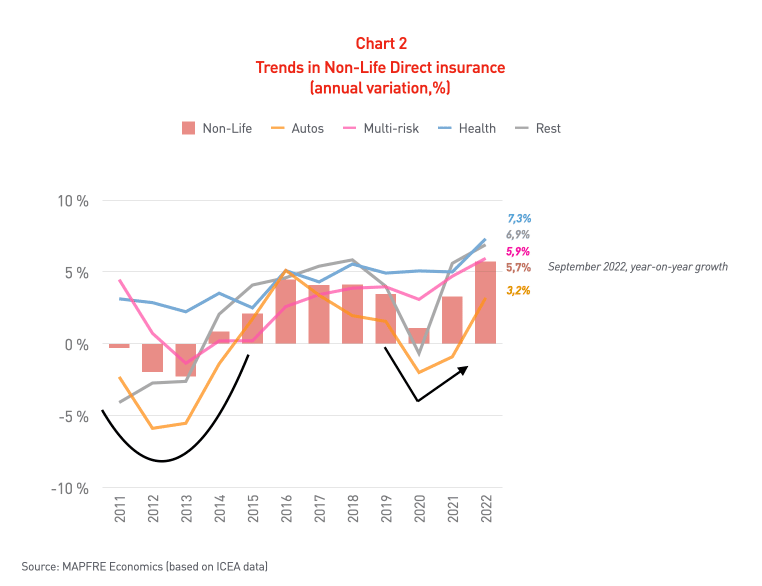
The combined ratio of Automobile insurance increased appreciably during 2021 at 6.3 pp, to 94.1%, due to a progressive average premium reduction caused by Covid, which gave rise to a competitive environment in new production and policies aimed at retaining portfolio policyholders. Additionally, mobility was renewed, reaching almost the same level of activity as before the pandemic, with the subsequent increase in the frequency of claims (see Table 1). The trend for 2022 is influenced by the economic environment of rising inflation. This caused an increase in the cost of claims, which led to erosion of the margins as it was not accompanied by a proportional increase in premiums (3.2% in the third quarter). In the first six months of 2022, the combined ratio has continued to worsen, reaching 96.4%, a 6.3 pp increase over the ration in September 2021.
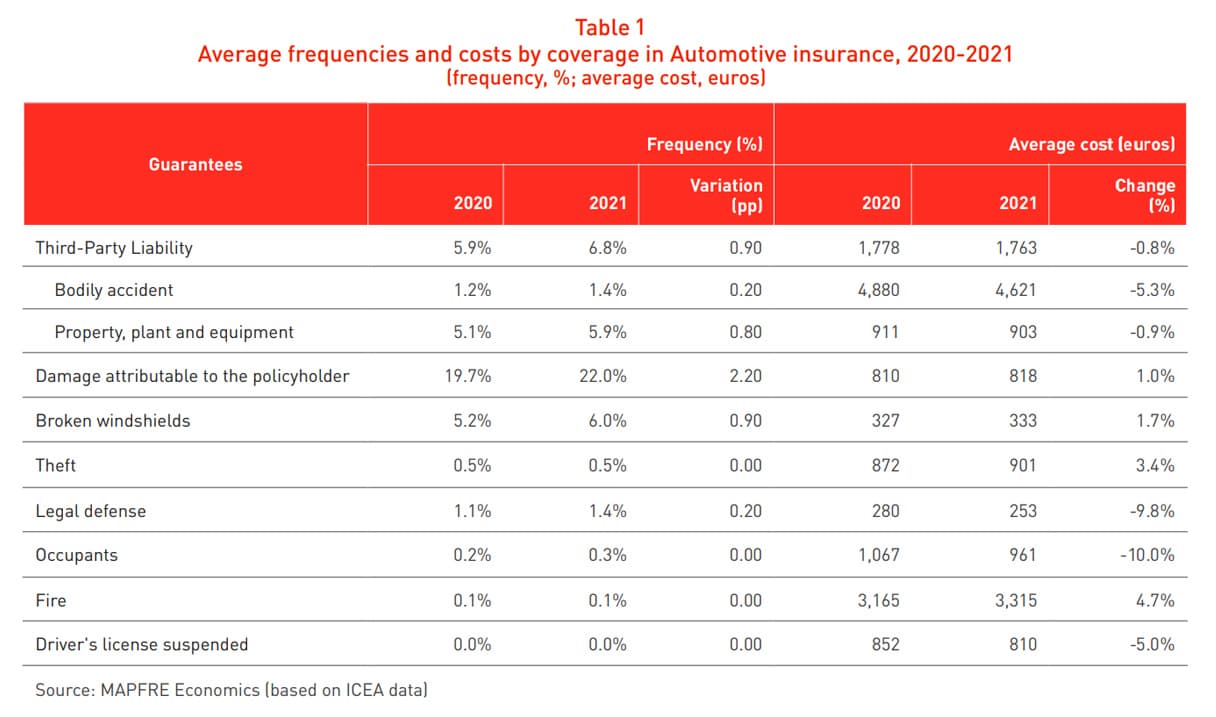
Health Insurance, in turn, has progressively increased its market share, to the current 25.7%, coming closer and closer to the Automobile line. In 2021, there was another increase in new production of Health Insurance, due to the population’s increased sensitivity to health, and the line showed a 5.0% increase in the volume of premiums issued. It must be stated that in 2021, health costs increased significantly due to non-urgent care policyholders had delayed due to the situation during the first months of the pandemic, which caused the loss ratio, combined ratio, and technical-financial result to return to levels very similar to those before the coronavirus.
Multirisk Insurance also performed favorably in 2021, with 4.7% premium growth, notably increases in Home and Industrial, of 4.9% and 5.8, respectively. The data published on the first nine months of 2022 show a year-on-year increase of 5.9% (14.7% when compared to the same period in 2019). The growth of Industrial Multirisk continues to stand out, at 9.3% (25.2% compared to the same period of 2019).
Finally, the Life Insurance business in 2021 reached a total premium volume of 23.55 billion Euros, with a 7.9% increase. The driver was Savings/Retirement insurance, which grew 9.1%, notably Income, with 49.7%, and unit linked at 22.1%. In terms of managed savings, technical provisions recovered the growth trend lost in 2020, and showed a slight increase of 0.8% in 2021, reaching 195.72 billion Euros, with a clear push from unit linked, which grew 23.5%.
After starting the year with a -21.8% drop, the Life business had been recovering in the next months until it recorded a year-on-year increase of 5.6% in the first nine months of 2022, with positive performance in both Life risk (+3.1%) and Life savings (6.4%), although this still represents a drop of -16.9% when compared to 2019 (see Chart 3).
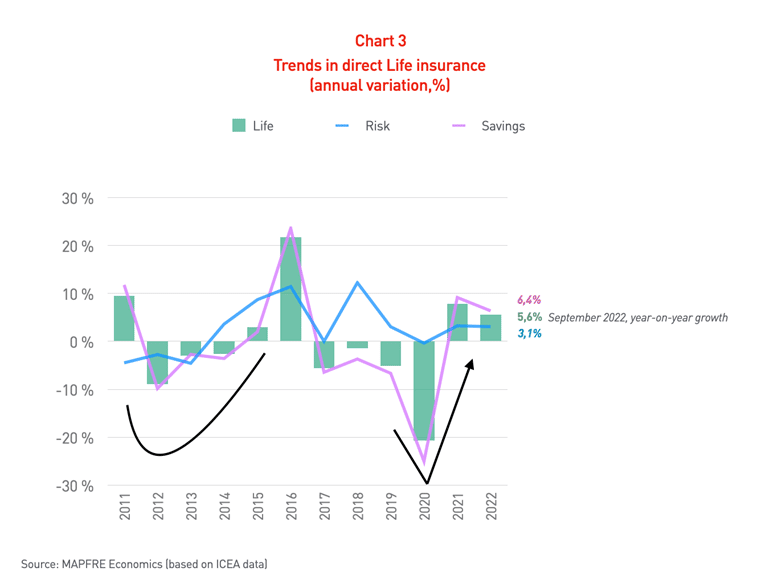
As regards technical profitability, the combined ratio for the Non-Life insurance segment in 2021 stood at 92.9%, an increase of 2.5 pp more than the value recorded in 2020 (90.5%), due to a worsening of the claims ratio by 2.2 pp, which stood at 69.2%. In turn, the administration expenses ratio remained unchanged at 5.3%, while the acquisition expenses ratio was 18.3%, increasing 0.3 pp (see Chart 4).
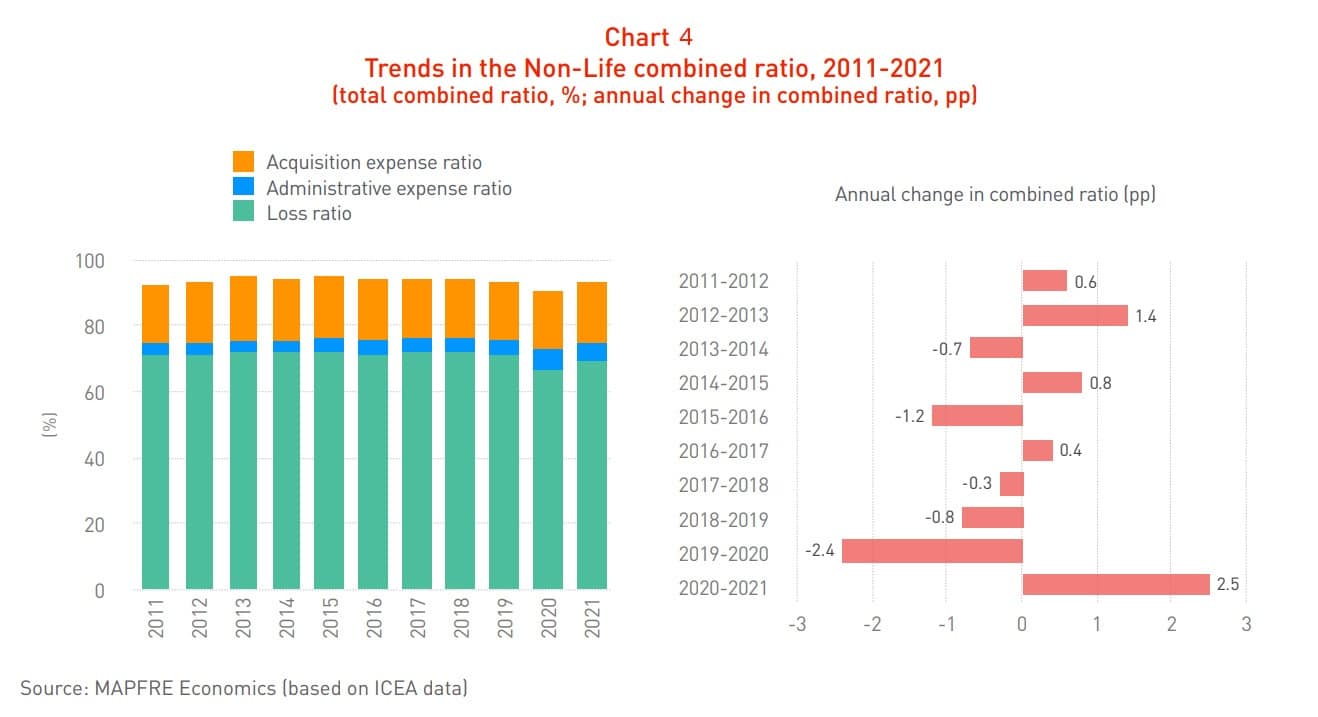
On the other hand, the profitability of financial investments in the insurance sector sat at 3.75% in 2021 (0.44 pp over that observed one year before), showing certain stability in an environment of prolonged ultra-accommodative monetary policy by the European Central Bank (see Chart 5). The total volume of investments of Spanish insurance companies in 2021 reached 332.92 billion euros, representing a regression of 2.8% versus the previous year.
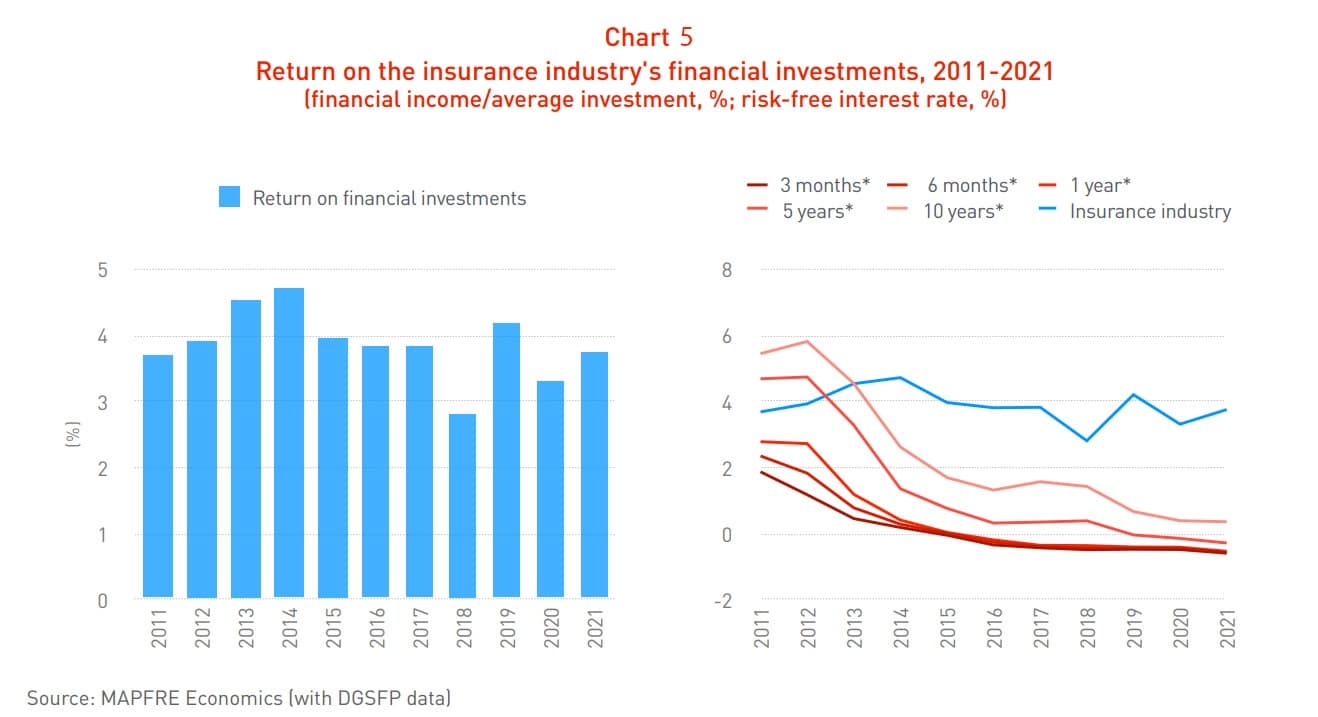
In view of the foregoing, the performance of insurance activity in 2021 recorded a return on equity (ROE) of 10.6%, 2.16 pp less than in 2020, and a return on assets (ROA) OF 1.42%, which shows a slight decrease of -0.2 pp versus 2020. In absolute values, the Spanish insurance sector reached 5.07 billion Euros in profits in 2021, which was a -12.5% decrease from the previous year’s data.
In reference to structural trends of the market in 2021, the penetration of Spanish insurance (ratio of premiums and GDP) had a slight drop, while density (premiums per capita) and deepening (Life Insurance premiums with respect to total premiums) showed relative progress this year. Thus, in 2021 there is only a partial change in the development trend of insurance activity in Spain that had been observed since 2017, which was characterized by a retraction in both penetration and deepening. So, in 2021, while penetration decreased again, deepening grew for the first time since 2016 (see Chart 6).
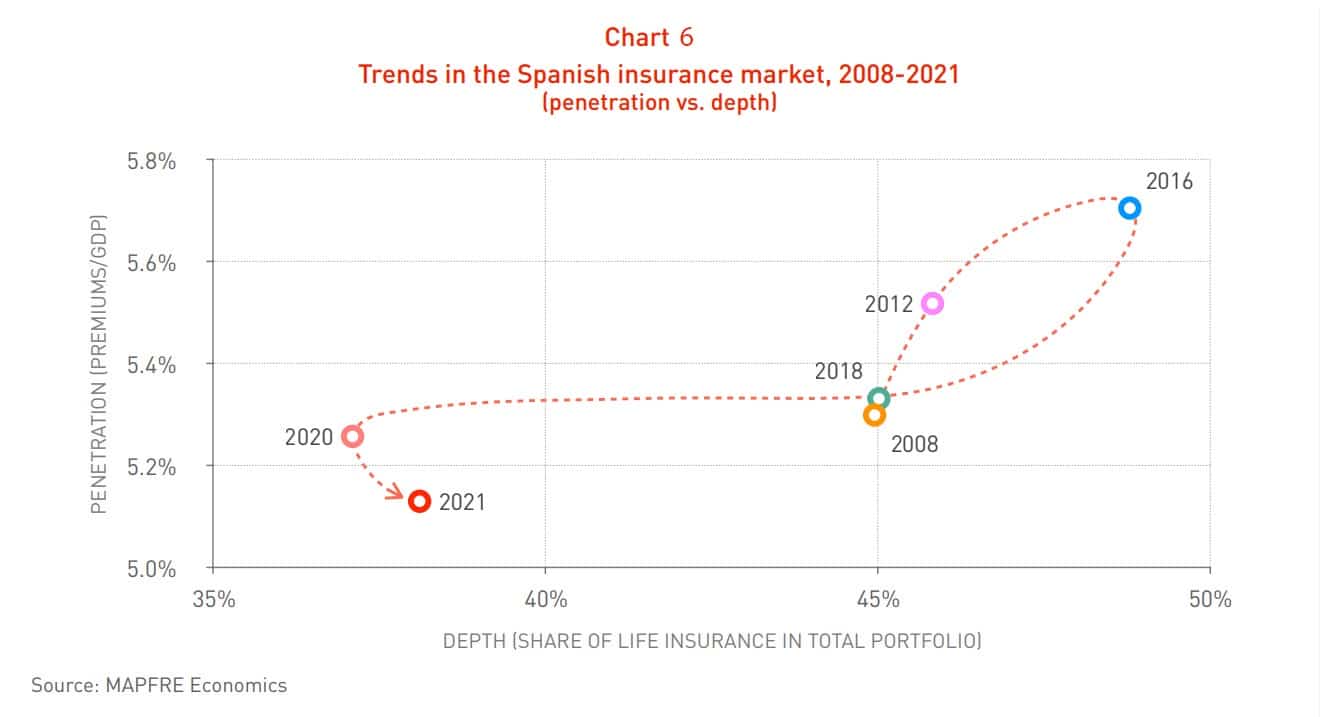
A detailed analysis of the different business lines and structural trends in the last decade can be found in the report The Spanish Insurance Market 2021, prepared by MAPFRE Economics and available at the following link:




